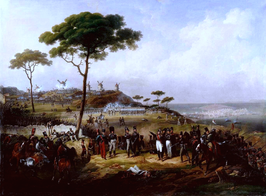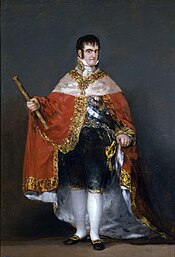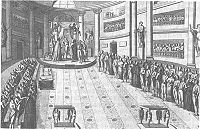Trienio Liberal
This article has multiple issues. Please help improve it or discuss these issues on the talk page. (Learn how and when to remove these messages)
No issues specified. Please specify issues, or remove this template. |
| Trienio Liberal | |||||||
|---|---|---|---|---|---|---|---|
 Episode of the French intervention in Spain 1823 by Hippolyte Lecomte | |||||||
| |||||||
| Belligerents | |||||||
|
|
| ||||||
| Commanders and leaders | |||||||
|
• Duke of Angoulême • Armand Guilleminot • Nicolas Oudinot • Gabriel Molitor • Bon de Moncey • Étienne Tardif de Pommeroux de Bordesoulle • Louis Aloy de Hohenlohe-Waldenburg-Bartenstein |
Rafael del Riego Pablo Morillo Francisco Ballesteros Francisco Espoz y Mina Miguel de Álava Count of La Bisbal Quiroga Garcés | ||||||
The Trienio Liberal (English: Liberal Triennium) was a period of three years of liberal domination of Spanish politics. It ended in conflict between royalists and liberals, with Bourbon France intervening on the side of the royalists. The revolutionaries of 1820 succeeded in forcing the monarchs of Spain and the southern Italian Kingdom of the Two Sicilies to grant liberal constitutions against their wills. It also involved a French invasion of Spain in April 1823, aimed at restoring King Ferdinand VII to the Spanish throne. This invasion is known in France as the "Spanish Expedition" (expédition d’Espagne), and in Spain as "The Hundred Thousand Sons of St. Louis".
Context

Spain's King Ferdinand VII provoked widespread unrest, particularly in the army, by refusing to accept the liberal Spanish Constitution of 1812. The King sought to reclaim the Spanish colonies in the Americas that had recently revolted successfully, consequently depriving Spain of an important source of revenue. In January 1820, soldiers assembled at Cadiz for an expedition to South America, angry over infrequent pay, bad food, and poor quarters, mutinied under the leadership of Colonel Rafael del Riego y Nuñez. Pledging fealty to the 1812 Constitution, they seized their commander. Subsequently the rebel forces moved to nearby San Fernando where they began preparations to march on the capital of Madrid.

Despite the rebels' relative weakness, Ferdinand accepted the constitution on March 9, 1820, granting power to liberal ministers and ushering in the so-called Liberal Triennium (el Trienio Liberal), a period of popular rule. However, in this liberal atmosphere, political conspiracies of both right and left proliferated in Spain, as was the case across much of Europe. Liberal revolutionaries stormed the King's palace and seized Ferdinand VII who was a prisoner of the Cortes in all but name for the next three years. During this time Ferdinand retired to Aranjuez. The elections to the Cortes Generales in 1822 were won by Rafael del Riego. Ferdinand's supporters set themselves up at Urgel, took up arms and put in place an absolutist regency. Ferdinand's supporters, accompanied by the Royal Guard, staged an uprising in Mardrid which was subdued by forces supporting the new government and its constitution.Despite the defeat of Ferdinand's supporters at Madrid, civil war erupted in the regions of Castile, Toledo, and Andalusia.



In 1822, Ferdinand VII applied the terms of the Congress of Vienna, lobbied for the assistance of the other absolute monarchs of Europe, in the process joining the Holy Alliance formed by Russia, Prussia, Austria and France to restore absolutism. In France, the ultra-royalists pressured Louis XVIII to intervene. To temper their counter-revolutionary ardor, the Duc de Richelieu deployed troops along the Pyrenees Mountains along the France-Spain border, charging them with halting the spread of Spanish liberalism and the "yellow fever" from encroaching into France. In September 1822 this "cordon sanitaire" became an observation corps and then very quickly transformed itself into a military expedition.
France considers intervention
The Holy Alliance (Russia, Austria and Prussia) refused Ferdinand's request for help, but the Quadruple Alliance (Britain, France, the Netherlands and Austria) at the Congress of Verona in October 1822 gave France a mandate to intervene and restore the Spanish monarchy. On 22 January 1823, a secret treaty was signed at the congress of Verona, allowing France to invade Spain to restore Ferdinand VII as an absolute monarch. With this agreement from the Holy Alliance, on 28 January 1823 Louis XVIII announced that "a hundred thousand Frenchmen are ready to march, invoking the name of Saint Louis, to safeguard the throne of Spain for a grandson of Henry IV of France". At the end of February, France's Chambres voted an extraordinary grant for the expedition. Châteaubriand and the ultra-royalists rejoiced - the royal army was going to prove its bravery and devotion in the face of Spanish liberals, fighting for the glory of the Bourbon monarchy.
The new prime minister, Joseph de Villèle, intended to oppose the war. The operation's cost was excessive, the army's organisation was defective and the troops' loyalty was uncertain. The superintendent of the military was unable to assure logistic support for the expedition's 95,000 men (as counted at the end of March) concentrated in the Basses-Pyrénées and the Landes with 20,000 horses and 96 artillery pieces. To remedy his doubts, he had to consult the munitions-supplier Ouvrard, who quickly concluded that marches in Spain were as favourable to his own interests as to those of the army, even if they would be to the detriment of the public treasury.
The French force

Command structure
The organisation of the expedition's command structure posed many problems. Pro-Bourbon commanders had to be given the chance to fully exercise the roles they had so recently been given by the restored French monarchy without compromising the army's loyalty or efficiency. The solutions was to give the secondary commands to former émigrés and Vendéens and the primary ones to former generals of the Revolution and First Empire. The duc d'Angoulême, son of Charles X, was made commander in chief of the armée des Pyrénées, despite his lack of military experience, but he agreed to hold it as a merely honorary role overseeing only the political direction of the expedition, leaving its military direction to his major-general Guilleminot, a tried-and-tested general of the First Empire. Four of the five army corps were placed under generals who had fought for Napoleon - marshal Oudinot, duc de Reggio, general Molitor, marshal Bon Adrien Jeannot de Moncey, duc de Conegliano and general Étienne Tardif de Pommeroux de Bordesoulle. The prince of Hohenlohe commanded the 3rd corps, the least-trusted of the 5, with only two divisions and 16,000 (as opposed to the 3 or 4 divisions and 20 to 27 thousand men in the other 4 divisions).
Loyalty
The expedition was made up of regiments in which many of the officers, NCOs and men had been marked by memories of the Napoleonic Wars and so were disposed more kindly towards the liberals than the French and Spanish Bourbons. The liberals hoped to dissuade them from fighting "for monks, against liberty". Villèle was worried at their propaganda in bars and billets, where a song by Béranger spread throughout March and April inciting the soldiers to mutiny:
Brav' soldats, v'la l'ord' du jour :
Point de victoire
Où n'y a point de gloire.
Brav' soldat, v'la l'ord' du jour :
Gard' à vous! Demi-tour![1]
Course
Outbreak
On 6 April, the doubts of some and the illusions of others dispersed. On the banks of the Bidassoa, 500 liberal French and Piedmontese men faced off against the forward-positions of the 9th Light Infantry Regiment. Brandishing a Tricolour flag and singing La Marseillaise, they incited the soldiers not to cross the frontier. The King's infantrymen hesitated until General Vallin rushed to them and ordered them to open fire. Several of the demonstrators were killed and the others dispersed. Many of them joined Englishmen under Colonel Robert Wilson, Belgians under Janssens and other French or Italian volunteers to form a liberal legion and a squadron of "liberty lancers" to fight beside the Spanish constitutional forces. The following day, on 7 April, the "100,000 Sons of Saint Louis" under the King's nephew Louis-Antoine, Duke of Angoulême entered Spain without opposition from the constitutional government's forces and with the supported by the middle-classes and part of the urban population.
French advance
In the north, Hohenlohe's 3rd Corps (reinforced in July by Lauriston's 5th Corps) forced General Morillo to retreat before rallying his troops. The French were left in control of Navarre, the Asturias and Galicia, however lacking siege equipment they were unable to blockade the towns where the liberals continued to resist for several more months. The city ofCoruna only surrendered on 21 August, Pampelune on 16 September, and San Sebastián on 27 September. To the east and southeast, Molitor pushed back General Ballesteros into Aragon, pursuing him as far as Murcia and Grenada, winning an engagement at Campillo de Arenas on 28 July and forcing his surrender on 4 August. At Jaén, he defeated the final columns of Rafael Riego, who was captured by the Absolutists on 15 September and hanged in Madrid on 7 November, two days before the fall of Alicante. In Catalonia, Moncey managed to quell General Mina's regular and guerrilla forces, with Barcelona only surrendering on 2 November.
Andalusian front
More decisive operations spread across Andalusia, since this was the site of Cádiz, transformed into the Constitutionalists' provisional capital and thus the French force's main strategic objective. It contained the Cortes and the imprisoned king and was defended by a garrison of 14,000 men. At first Riego, then the generals La Bisbal, Quiroga and Alava led the action. Access to the city was protected by the batteries of fort Santa Catalina and fort San Sebastian to the west, fort Santi-Pietri to the east and above all by the fortified peninsula of Trocadéro, where colonel Garcés positioned 1700 men and 50 guns.
Under the command of general Bordesoulle, soon joined by the duc d'Angoulême and Guilleminot, the infantry of generals Bourmont, Obert and Goujeon, the cavalry of Foissac-Latour, the artillery of Tirlet and the engineers under Dode de La Brunerie took up positions before Cádiz from mid-July. Forced to use several naval divisions for surveillance of Spain's Atlantic and Mediterranean ports and coasts (held by the Constitutionalists), the French navy was only able to spare a small squadron of 10 ships under counter admiral Hamelin to blockade the city. This proved too small a force for Hamelin to succeed in this mission and so on 27 August he was replaced by counter-admiral des Rotours, then by Duperré, who only arrive on 17 September, with meagre reinforcements.
Conclusion
On 31 August the French infantry assaulted Fort du Trocadéro and at the cost of 35 killed and 110 wounded (as opposed to 150 dead, 300 wounded and 1,100 captured on the part of the garrison) successfully captured it, turning its powerful guns towards Cádiz. On 20 September fort Sancti-Petri fell in its turn in a combined army-navy operation. On 23 September the guns of the Sancti-Petri and Trocadero forts and of Duperré's fleet bombarded the town and on 28 the constitutionalists adjudged the town lost. Thus the Cortes decided to dissolve itself, give back absolute power to Ferdinand VII and hand him over to the French. On 30 September Cádiz surrendered and on 3 October more than 4,600 French troops landed at its port. The French army fired its last shots in Spain at the start of November. On 5 November, the duc d'Angoulême left Madrid and re-entered France on 23 November, leaving behind an occupying force of 45,000 men under the command of Bourmont. Spain was then progressively evacuated, and was only fully completed in 1828. Unexpectedly, Ferdinand took ruthless revenge on his opponents, revoked the 1812 constitution and restored absolute monarchy to Spain.
Consequences
The liberals thus negotiated their return in exchange for Ferdinand's oath to respect the Spanish laws - he accepted. However, on 1 October 1823, feeling bolstered by French forces, Ferdinand broke his oath and again repealed the Constitution of Cádiz and declared null and void all the acts and measures of the liberal government.
This war also seriously disturbed Spanish efforts to crush the independence struggles in Latin America.
Chateaubriand, foreign minister in France's Villèle government (from 28 December 1822 to 6 June 1824), contrasted the expedition's success with France's failure in the Peninsular War:
Striding across the Spains, succeeding where Bonaparte had failed, triumphing on the same soil where a great man's arms had suffered setbacks, doing in six months what he was unable to do in seven years, was a true miracle![2]
Bibliography
In French
- Encyclopédie Universalis, Paris, Volume 18, 2000
- Larousse, tome 1, 2, 3, Paris, 1998
- Caron, Jean-Claude, La France de 1815 à 1848, Paris, Armand Colin, coll. « Cursus », 2004, 193 p.
- Corvisier, André, Histoire militaire de la France, de 1715 à 1871, tome 2, Paris, Presses universitaires de France, "Quadrige" collection, 1998, 627 p.
- Demier, Francis, La France du XIXe 1814-1914, Seuil, 2000, 606 p.
- Dulphy, Anne, Histoire de l'Espagne de 1814 à nos jours, le défi de la modernisation, Paris, Armand Colin, "128" collection, 2005, 127 p.
- Duroselle, Jean-Baptiste, L'Europe de 1815 à nos jours : vie politique et relation internationale, Paris, Presses Universitaires de France, "Nouvelle clio" collection, 1967, 363 p.
- Garrigues, Jean, Lacombrade, Philippe, La France au 19e siècle, 1814-1914, Paris, Armand Colin, "Campus" collection, 2004, 191 p.
- Lever, Evelyne, Louis XVIII, Paris, Fayard, 1998, 597 p.
- Jean Sarrailh, Un homme d'état espagnol: Martínez de la Rosa (1787–1862) (Paris, 1930)
In Spanish
- Miguel Artola Gallego, La España de Fernando VII (Madrid, 1968)
- Jonathan Harris, 'Los escritos de codificación de Jeremy Bentham y su recepción en el primer liberalismo español', Télos. Revista Iberoamericana de Estudios Utilitaristas 8 (1999), 9-29
- W. Ramírez de Villa-Urrutia, Fernando VII, rey constitucional. Historia diplomática de España de 1820 a 1823 (Madrid, 1922)
In English
- Raymond Carr, Spain 1808-1975 (Oxford, 1982, 2nd ed.)
- Charles W. Fehrenbach, ‘Moderados and Exaltados: the liberal opposition to Ferdinand VII, 1814-1823’, Hispanic American Historical Review 50 (1970), 52-69
- Jonathan Harris, 'An English utilitarian looks at Spanish American independence: Jeremy Bentham's Rid Yourselves of Ultramaria', The Americas 53 (1996), 217-33
See also
- Spanish Constitution of 1812, also affectionately known as La Pepa
- Battle of Trocadero
- History of Spain
- Military career of Simón Bolívar
References
- ^ Brave soldiers, this is the order of the day - what is the point of victory where there is no glory?
- ^ Chateaubriand, Mémoires d'outre-tombe
